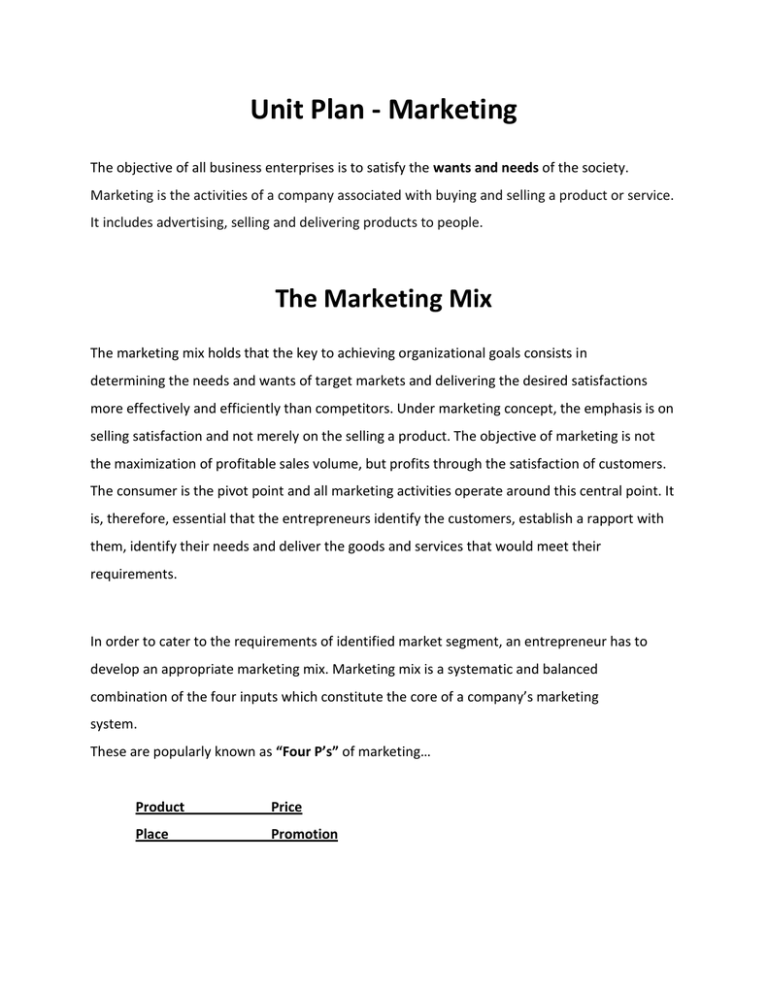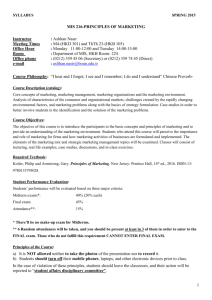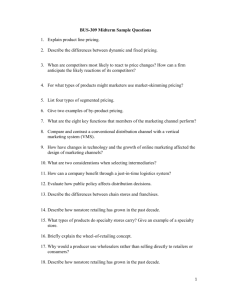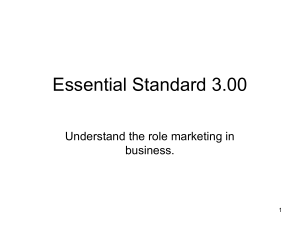Marketing Unit Notes - Filled
advertisement

Unit Plan - Marketing The objective of all business enterprises is to satisfy the wants and needs of the society. Marketing is the activities of a company associated with buying and selling a product or service. It includes advertising, selling and delivering products to people. The Marketing Mix The marketing mix holds that the key to achieving organizational goals consists in determining the needs and wants of target markets and delivering the desired satisfactions more effectively and efficiently than competitors. Under marketing concept, the emphasis is on selling satisfaction and not merely on the selling a product. The objective of marketing is not the maximization of profitable sales volume, but profits through the satisfaction of customers. The consumer is the pivot point and all marketing activities operate around this central point. It is, therefore, essential that the entrepreneurs identify the customers, establish a rapport with them, identify their needs and deliver the goods and services that would meet their requirements. In order to cater to the requirements of identified market segment, an entrepreneur has to develop an appropriate marketing mix. Marketing mix is a systematic and balanced combination of the four inputs which constitute the core of a company’s marketing system. These are popularly known as “Four P’s” of marketing… Product Price Place Promotion The Marketing Mix (the 4 P’s of Marketing) includes: Product, Place (Distribution), Price, Promotion The 4 “P’s” is universal speak for the marketing mix (a blending of these elements to reach a target market): Product: The first element of marketing mix is product. A Product is anything that can be offered to a market for attention, acquisition, use, or consumption that might satisfy a want or need. Products include physical objects, services, events, persons, places, ideas or mixes of these. This element involves decisions concerning product line, quality, design, brand name, label, after sales services, warranties, product range, etc. An appropriate combination of features and benefits by the small firm will provide the product with USP (unique selling proposition). This will enhance the customer loyalty in favor of its products. Products and services are broadly classified into consumer products and industrial products. Consumer products are bought for final consumption; whereas Industrial products are bought by individuals and organizations for further processing or for use in conducting business. Distribution (Place): This is another key marketing mix tool, which stands for the various activities the company undertakes to make the product available to target customers. Place mix or delivery mix is the physical distribution of products at the right time and at the right place. It refers to finding out the best means of selling, sources of selling (wholesaler, retailers, and agents), inventory control, storage facility, location, warehousing, transportation, etc. This includes decisions about the channels of distribution, which make the product available to target customers at the right time, at the right place and at the right price. This will be discussed in detail in Chapter-18. By selecting wrong distribution channels or by using the ones it has traditionally used, a small firm could be depriving it of new market opportunities. In a situation where a small firm has only one primary product, the general rise and fall of sales will lead to a rise and fall of the firm, unless the firm learns to consistently adjust its marketing mix to match consumer demand. Price: The second element is the price, which affects the volume of sales. It is one of the most difficult tasks of the marketing manager to fix the right price. The variables that significantly influence the price of a product are: demand of the product, cost of the product, competition and government regulation. The product mix includes: determination of unit price of the product, pricing policies and strategies, discounts and level of margins, credit policy, terms of delivery, payment, etc. Pricing decisions have direct influence on the sales volume and profits of the firm. Price, therefore, is an important element of the marketing mix. Right price can be determined through pricing research and by adopting test-marketing techniques. Promotion: Promotion refers to the various activities undertaken by the enterprise to communicate and promote its products to the target market. The different methods of promoting a product are through advertisement, personal selling, sales promotion and publicity. Now we go into more details of the four P’s Product Product Mix is the different products (or services) a business sells. For example…Ralph Lauren sells shirts, shoes, hats, pants, socks, umbrellas, coats, etc. Product Features are the different colors, sizes, qualities of the products which make up the product mix. Positioning is placing a product in a certain market to get a desired customer response. Distribution (Place) Channels of Distribution are the routes that products and services take from the time they are produced to the time they are consumed. The entrepreneur needs to find the most efficient way to ship products to desired locations in a timely manner By having efficient channels of distribution a business owner should be able lower his/her costs…these savings may be passed onto their customer in the form of lower prices or the business owner could choose not to pass the savings onto the customer, but instead increase his/her profitability Channels of Distribution for retail goods include: Convenient Hours (nights/weekends) Catalogs, Fliers and ads for non-area customers Take orders by phone/fax and send to customers Create a Web Site for your business o Lets you to provide Product Information and allows your customers to place an order through the Internet Receiving Goods to Sell: • All businesses need to buy supplies, materials, and goods and services to resell…You need to locate distributors, wholesalers, and manufacturers through: Physical Distribution: • Includes not only transportation, but also storage and handling of products within a channel • It is important for storage facilities to be adequate and safe Price • Your pricing must be low enough to compete with competition BUT • High enough to cover costs and earn a profit • Before you can select a pricing strategy, you will need to establish objectives for your pricing program. Examples of pricing objectives include: • Maximize sales Increase profits Maintain Image Attract customers Discourage competition Once you have considered your pricing objectives you must then determine the possible prices to charge…there are 3 possible pricing methods: Demand-Based Pricing - pricing is determined by how much customers are willing to pay for the product or service. Cost-Based Pricing - pricing is determined by using the wholesale cost of an item as the basis for the price charged. • Markup Price - price is determined by adding an amount to the wholesale cost of an item. The formula you use is: • Wholesale Cost X Percentage Markup = Markup Amount then • Wholesale Cost + Markup Amount = Retail Price Example of Markup Pricing… Assume a can of artichokes hearts costs you $1.77 and you decide to add 40% to your wholesale cost to determine your retail price that you charge your customers… Wholesale Cost X Percentage Markup = Markup Amount $1.77 X .40 = $.71 then you add the markup amount to your wholesale cost Wholesale Cost + Markup Amount = Retail Price $1.77 + .71 = $2.48 • Markdown Price - price is determined by subtracting an amount from the retail price of an item Competition-Based Pricing - pricing is determined by considering what your competitors charge for the same product or service Pricing a Service: Time-Based Pricing is when the price you charge your customers for the service is based on how long it takes to complete the service. (lawyers, plumbers, cleaning service) Example…assume you are a lawyer and you charge your clients $150.00 per hour. Next, assume that you spent 22 hours on Mr. Slob’s case…how much do you charge him? Bundling is when you bundle or combine a number of services and charge one price for all of the services instead of charging the customer separately for each service (Triple Play) Breakeven Point is the lowest price identified in the price range is based on the costs of the product or service sold to the seller. When using this method you must include all of the expenses involved in making and selling the service or product. To determine the breakeven point you… Total fixed costs / (selling price - variable costs) = breakeven point Promotion The Promotional Mix is a strategy for promoting your business by using some or all of the following: • Advertising • Publicity • Sales Promotion • Personal Selling Advertising is a paid form of communication sent out by a business about a product or service. Advertising should help a business convey a positive image. Public Relations is the act of establishing a favorable relationship with customers and the general public. Advertising should clearly communicate your intended message and image you want. For example, if you want to be known as the business with the lowest prices then you should make sure that your advertising highlights your good prices. There are different forms of advertising some include: Television Advertising – best way to reach a large number of people quickly, but it costs a lot and often reaches a too broad. Radio Advertising – reaches a lot of people and you can target the channel that plays to the same group of people that you consider your target market. It has the disadvantage of being purely audio message and you can’t show your products. Newspaper Advertising – good for small businesses because it: o Is relatively inexpensive o Targets a limited geographic area o Reaches a large number of people Telephone Directory Advertising – Disadvantage is that people only look in the directory when they are already in search of the particular type of business. Direct Mail Advertising Magazine Advertising Outdoor/Billboards Advertising Transit Advertising Publicity - free promotion generated by media coverage Press Release – a written statement meant to inform the media of an event or product Personal selling is direct communication between a prospective buyer and a sales representative in which the sales representative attempts to influence the perspective buyer in a purchase situation. Sales representatives should know: 1. Product Knowledge – sales rep must understand the features of the product and the benefits that the buyer will enjoy if they make the purchase. 2. Determine Customer Needs and Wants – sales rep must know what needs or wants will be fulfilled by buying the product. Other Types of Promotion Sales Promotion is the act of offering an incentive to customers in order to increase sales. Sales promotion might take the form of: • Contests • Free samples • Coupons • Rebates • Frequent buyer program • Gifts • Special events • Rebates- a rebate is a refund offered to people who purchase a product Telemarketing is using the phone to market your product or service. Miscellaneous Marketing Concepts and Terms Market Share is the percentage of a market owned by a business. The total market for a product must be known in order for a market share to be determined. Your market share will depend on the level of competition in your market. If you create a market for an entirely new product or service you will have 100% of market share…at least for a while until other competitors enter the market. There are many ways to increase your Market Share…as we already know some ways are… Lower prices More advertising and promotion Providing a better product or service than your competitors Providing better customer service More convenient hours for your customers But there is also… Networking is establishing informal ties with people who can help your business grow. Joining organizations like the Rotary Club, trade associations, local sport leagues, the Chamber of Commerce, the alumni association of your college. Branding – Logo & Slogan Logo – A logo is a graphic mark or emblem commonly used by commercial enterprises, organizations and even individuals to aid and promote instant public recognition. Logos are either purely graphic (symbols/icons) or are composed of the name of the organization Slogan – A slogan is a memorable motto or phrase used in a political, commercial, religious, and other context as a repetitive expression of an idea or purpose. Slogans vary from the written and the visual to the chanted and the vulgar. Their simple rhetorical nature usually leaves little room for detail, and a chanted slogan may serve more as social expression of unified purpose, than as communication to an intended audience. Trademark – A trademark is a recognizable sign, design or expression which identifies products or services of a particular source from those of others. The trademark owner can be an individual, business organization, or any legal entity. A trademark may be located on a package, a label, a voucher or on the product itself. Copyright – Copyright is a legal concept, enacted by most governments, giving the creator of an original work exclusive rights to it, usually for a limited time. Generally, it is "the right to copy", but also gives the copyright holder the right to be credited for the work, to determine who may adapt the work to other forms, who may perform the work, who may financially benefit from it, and other related rights. It is a form of intellectual property (like the patent, the trademark, and the trade secret) applicable to any expressible form of an idea or information that is substantive and discrete. Patent – A patent is a set of exclusive rights granted by a sovereign state to an inventor or their assignee for a limited period of time, in exchange for the public disclosure of the invention. An invention is a solution to a specific technological problem, and may be a product or a process. Patents are a form of intellectual property. Stages in Product Life Cycle The product moves through the four stages namely… introduction growth maturity decline As the product moves through different stages of its life cycle, sales volume and profitability change from stage to stage as shown in the figure below. The entrepreneur’s emphasis on the marketing mix elements also undergoes substantial changes from stage to stage. A brief discussion of the marketing strategies in different stages of the PLC is given below: Introduction: The first stage of a product life cycle is the introduction or pioneering stage. Under this state the fixed costs of marketing and production will be high, competition is almost non-existent, markets are limited and the product is not known much. Prices are relatively high because of small scale of production, technological problems and heavy promotional expenditure. Profits are usually non-existent as heavy expenses are incurred for introducing the product in the market. To introduce the product successfully, the following strategies may be adopted: a. Advertisement and publicity of the product. ‘Money back’ guarantee may be given to stimulate the people try the product. b. Attractive gift to customers as an ‘introductory offer’. c. Attractive discount to dealers. d. Higher price of product to earn more profit during the initial stages. Growth: The sales as well as the profits increase rapidly as the product is accepted in the market. The promotional expenses remain high although they tend to fall as a ratio to sales volume. Quite often, smaller firms move into the market during the growth phase. With their flexibility they can move very quickly and capture a valuable part of the market without the huge investment risks of the development phase. In this stage, the competition increases and distribution is greatly widened. The marketing management focuses its attention on improving the market share by deeper penetration into the existing markets and entry into new markets. Sometimes major improvements also take place in the product during this stage. The following strategies are followed during the growth stage: a. The product is advertised heavily to stimulate sale. b. New versions of the product are introduced to cater to the requirements of different types of customers. c. The channels of distribution are strengthened so that the product is easily available wherever required. d. Brand image of the product is created through promotional activities. e. Price of the product is competitive. f. There is greater emphasis on customer service. Maturity: The product enters into maturity stage as competition intensifies further and market gets stabilized. There is saturation in the market as there is no possibility of sales growth. The product has been accepted by most of the potential buyers. Profits come down because of stiff competition and marketing expenditures rise. The prices are decreased because of competition and innovations in technology. This stage may last for a longer period as in the case of many products with long-run demand characteristics. But sooner or later, demand of the product starts declining as new products are introduced in the market. Product differentiation, identification of new segments and product improvement are emphasized during this stage. In order to lengthen the period of maturity stage, the following strategies may be adopted: a. Product may be differentiated from the competitive products and brand image may be emphasized more. b. The warranty period may be extended. c. Reusable packaging may be introduced. d. New markets may be developed. e. New uses of the product may be developed. Decline: This stage is characterized by either the product’s gradual displacement by some new products or change in consumer buying behavior. The sales fall down sharply and the expenditure on promotion has to be cut down drastically. The decline may be rapid with the product soon passing out of market or slow if new uses of the product are found. Profits are much smaller and companies need to assess their investment policies, looking towards investing in newer and more profitable product lines. End of Unit Questions What is marketing? Distinguish between marketing and selling. What is market segmentation? Describe the bases on which a market can be segmented by a small scale entrepreneur. What is marketing mix? Explain its main components. Explain the importance of market in a small scale enterprise. What is Product life cycle? Explain its various stages. Suggest appropriate marketing strategies for each of the stages of the PLC. Explain how the marketing mix should be changed during the various stages of the PLC. Discuss the significance of the PLC. How can entrepreneur check the decline of the product? Write short notes on: (a) consortium marketing and (b) tender marketing. Discuss the problems faced by the small-scale entrepreneurs in marketing their products.







